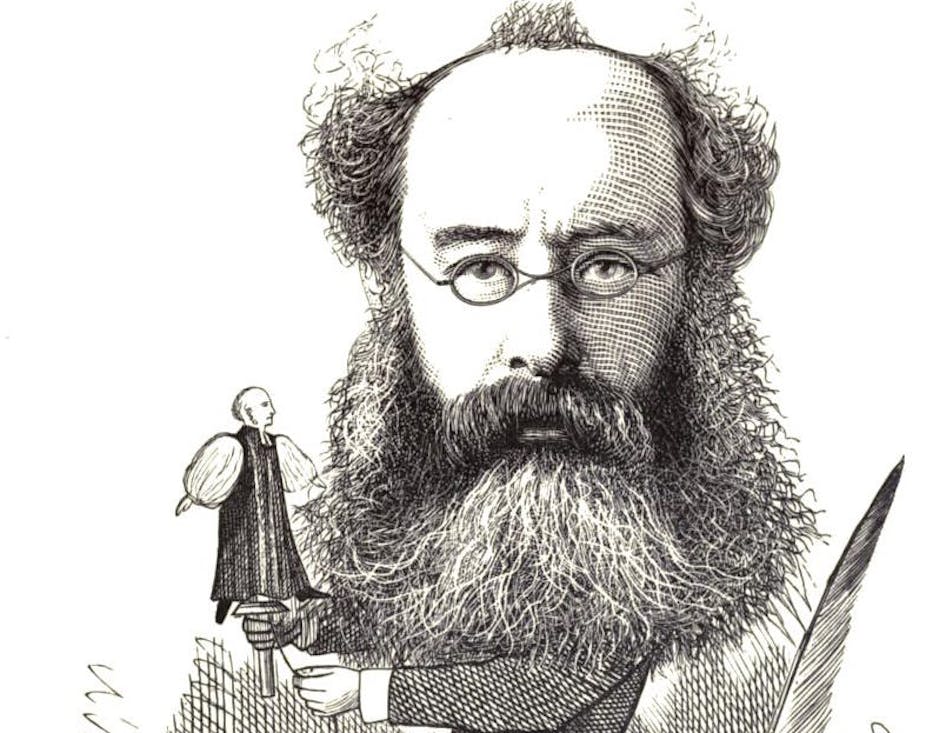Anthony Trollope may not, generally, be a staple part of people’s understanding of Victorian literature. He hasn’t fared quite as well as Dickens or Eliot. But seeing as he’s recently turned 200, and you may glimpse him on your stamps over breakfast soon enough, it seems like a good time to encourage you to read him.
Trollope wrote and published tirelessly. At his most popular in the 1860s, he dominated the literary scene as far as the prosperous middle-classes were concerned. Readers thought and wrote about his characters almost as though they were real people, and his was the picture of the life of the professional and landed classes which people recognised and believed in. Dickens, it is true, consistently sold more copies, having more readers from less well-off households. One might say that everyone who read Trollope also read Dickens, but that not all readers of Dickens were Trollope fans.

Trollope specialised in the lives of the middle and upper classes, and the efforts of individuals to behave morally in a world which was changing rapidly, in which fortunes were made and lost, and marriages might be made as much for money as love. It is the world of Jane Austen updated into the world of railways, steamships, telegraphs, electoral reform, and arguments for the rights of women and the political representation of the working class.
Life was more hectic. From the deepest countryside, trains took people to London every day, and brought London fashions, London money, London crime and London thinking down into the countryside. Even in the Church of England, new ideas, social and political ambition and the pursuit of wealth were daily more apparent.
Trollope’s novels are amusing, immensely engaging and frequently moving, but at their core is the age-old problem of how to lead a good life in a dangerous and possibly wicked world. His characters constantly question whether in choosing to do the best things for themselves, they can also do good things for their families and humanity as a whole.
Trollope’s women
Young women and men long for a marriage which will satisfy the contradictory desires for romance, sexual satisfaction, prosperity and social respectability. Victorians are often accused of ignoring characters’ sexuality, yet Trollope has one aristocratic young woman say she would like to be “notched” by a handsome young member of parliament, and the teenage daughter of a respectable family say that for men marriage must be like buying cheese: you want to taste several before you buy.
His novels have to be read perceptively, and here is an obstacle to popularity today. They are long, and demand we become interested in all the shades of thought and feeling surrounding the members of middle or upper-class families of the period 1850-1882. Yet look beyond the period detail and Trollope is the male novelist of the period who gives his women characters the most convincing thoughts and ambitions.
His women are by and large as intelligent and often as well-informed as his men. You can’t say this about Dickens, Thackeray, Meredith or Collins. But of course to be socially acceptable Trollope’s novels are so written that, as the Victorians would say, a mother could allow her daughter to read them.
Above all, they’re fun. Take the word of the princess royal. Writing to her mother, Queen Victoria, in 1858, she said:
I like Barchester Towers very much, it makes one laugh till one cries, it is so very true; but I think it mischievous and rather wicked.
And Cardinal Newman reportedly woke in the night laughing at what he’d read.

Where to begin?
Barchester Towers (1857) is a good one to start with. It’s early Trollope, and you may not be interested in the politics of the cathedral close, but there is still much to enjoy. Doctor Thorne (1858) is equally readable. The Eustace Diamonds (1871-2) is the favourite for its humour and ingenuity, and is, incidentally the book that the blind old man in TS Eliot’s Gerontion (partly based on the poet Edward Fitzgerald) is waiting for his “boy” to read to him.
Many are more challenging, such as The Way We Live Now (1874-5), a sustained attack on a society dominated by money and speculation, where plutocrats wield disproportionate political power. The Prime Minister (1875-6) is a much misunderstood work about the renunciation of power by a wealthy aristocratic politician who loves the old values he grew up with, but, like his author, conscientiously wants political power and prosperity to spread more broadly.
Trollope thought it hard to lead an honest and satisfying life in an imperfect world. It is difficult to see why people think that because Trollope understood and laughed at his age, he acquiesced in it unquestioningly. The fact is that he was transformed by his critics into a stuffy conformist, because so many of his critics have over the years been stuffy conformist themselves.
Read Trollope with an open mind and have patience for the writing of a more leisured age. Just follow the narrator and you’ll find your way through the immensely rich world of this great mid-Victorian novelist.

